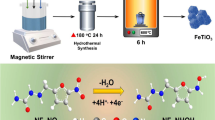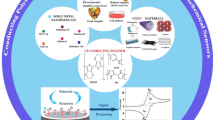Abstract
A dual-sensing platform is proposed based on multi-walled carbon nanotubes/Prussian blue–functionalized polypyrrole nanowire array (PPY/MWCNTs/PB). Highly aligned PPY nanowire arrays were electrochemically prepared on the surface of glassy carbon electrodes, which were doped with MWCNTs/PB nanocomposites. The nanomaterial combines the characteristics of the PPY nanowires (high conductivity and large specific surface area) and MWCNTs/PB (excellent catalytic performance and intrinsic redox activity). Owing to the nanowire microstructure and outstanding electrical properties, the PPY/MWCNTs/PB nanowire arrays show excellent electrocatalysis of the reduction of hydrogen peroxide and facilitate the construction of a high-performance biosensing platform for microRNA (miRNA). A linear relationship between analytical signal and concentration of hydrogen peroxide and miRNA was obtained in the range 5 to 503 µM (1.4–5.1 mM) and 0.1 pM to 1 nM, and detection limits of 1.7 μM and 33.4 fM, respectively. This new supersensitive sensing platform has broad application prospects of biomolecule and other analyte determination in drug, biomedical, plant protection, and environmental analysis.
Graphical abstract

Prussian blue/multi-walled carbon nanotubes functionalized polypyrrole nanowire arrays (PPY/MWCNTs/PB) were prepared by a facile one-step electrochemical method. PPY/MWCNTs/PB nanowire arrays show excellent electrocatalysis of the reduction of H2O2 and facilitate the construction of a high-performance biosensing platform for microRNA.









Similar content being viewed by others
References
Wanekaya AK, Chen W, Myung NV, Mulchandani AJE (2010) Nanowire-based Electrochemical Biosensors electroanalysis 18(6):533–550
Jin C, Lu F, Cao X, Yang Z, Yang R (2013) Facile synthesis and excellent electrochemical properties of NiCo2O4 spinel nanowire arrays as a bifunctional catalyst for the oxygen reduction and evolution reaction. J Mater Chem A 1(39):12170
Li Y, Li N, Ge J, Xue Y, Niu W, Chen MI, Du Y, Ma P X, Lei B (2019) Biodegradable thermal imaging-tracked ultralong nanowire-reinforced conductive nanocomposites elastomers with intrinsical efficient antibacterial and anticancer activity for enhanced biomedical application potential. Biomaterials 201:68–76
Guiseppi-Elie A (2010) Electroconductive hydrogels: synthesis, characterization and biomedical applications. Biomaterials 31(10):2701–2716
Da CSCG, Tristan, De La Torre Medina J, Lemaitre M, Piraux LJNRL (2016) Magnetic and magnetoresistive properties of 3D interconnected NiCo nanowire networks. Nanoscale Res Lett 11(1):466
Zhao Y, Liu B, Pan L, Yu GJE, Science E (2013) 3D nanostructured conductive polymer hydrogels for high-performance electrochemical devices. Nanoscale Res Lett 6(10):2856
Ramanathan K, Bangar MA, Yun M, Chen W, Myung NV, Mulchandani A (2005) Bioaffinity sensing using biologically functionalized conducting-polymer nanowire. J Am Chem Soc 127(2):496–497
White HS, Kittlesen GP, Wrighton MS (1984) ChemInform abstract: chemical derivatization of an array of three gold microelectrodes with polypyrrole: fabrication of a molecule-based transistor. J Am Chem Soc 15(51):5375–5377
Lupu A, Lisboa P, Valsesia A, Colpo P, Rossi F (2009) Hydrogen peroxide detection nanosensor array for biosensor development. Sensors Actuators B Chem 137(1):56–61
Huo W, Zhang X, Liu X, Liu H, Zhu Y, Zhang Y, Ji J, Dong F, Zhang Y (2020) Construction of advanced 3D Co3S4@PPy nanowire anchored on nickel foam for high-performance electrochemical energy storage. Electrochim Acta 334:135635
Tran HD, Shin K, Hong WG, D'Arcy JM, Kojima RW, Weiller BH, Kaner RB (2010) A template-free route to polypyrrole nanofibers. Macromol Rapid Commun 28(24):2289–2293
Zang J, Li CM, Bao SJ, Cui X, Bao Q, Sun CQ (2008) Template-free electrochemical synthesis of superhydrophilic polypyrrole nanofiber network. Macromol Rapid Commun 41(19):7053–7057
Zhang X, Manohar SK (2004) Bulk synthesis of polypyrrole nanofibers by a seeding approach. J Am Chem Soc 126(40):12714–12715
Huang J, Kai W, Wei Z (2010) Conducting polymer nanowire arrays with enhanced electrochemical performance. J Mater Chem A 20:1117–1121
Chen G, Wang H, Zhai W (2015) Enhanced thermoelectric property by the construction of a nanocomposite 3D interconnected architecture consisting of graphene nanolayers sandwiched by polypyrrole nanowires. J Mater Chem C 3(8):1649–1654
Husmann S, Zarbin AJG (2016) Design of a prussian blue analogue/carbon nanotube thin-film nanocomposite: tailored precursor preparation, synthesis, characterization, and application. Chem Eur J 22(19):6643–6653
Zhang M, Hou C, Halder A, Ulstrup J, Chi Q (2017) Interlocked graphene-prussian blue hybrid composites enable multifunctional electrochemical applications. Biosens Bioelectron 89(Part 1):570–577
Dempsey E, Diamond D, Biosensors A C J, Bioelectronics (2004) Development of a biosensor for endocrine disrupting compounds based on tyrosinase entrapped within a poly(thionine) film. Biosens Bioelectron 20(2):367–377
Gholivand MB, Ahmadi E, Haseli M (2017) A novel voltammetric sensor for nevirapine, based on modified graphite electrode by MWCNs/poly(methylene blue)/gold nanoparticle. Anal Biochem 527:4–12
Komkova MA, Pasquarelli A, Andreev EA, Galushin AA, Karyakin AA (2020) Prussian blue modified boron-doped diamond interfaces for advanced H2O2 electrochemical sensors. Electrochim Acta 339:135924
Wang L, Tricard S, Cao L, Liang Y, Zhao J, Fang J, Shen W (2015) Prussian blue/1-butyl-3-methylimidazolium tetrafluoroborate-graphite felt electrodes for efficient electrocatalytic determination of nitrite. Sensors Actuators B Chem 214:70–75
Cinti S, Cusenza R, Moscone D, Arduini F (2018) Paper-based synthesis of Prussian Blue Nanoparticles for the development of whole blood glucose electrochemical biosensor. Talanta 187:59–60
Li Y, Li Y, Hong M, Bin Q, Lin Z, Lin Z, Cai Z, Chen GN (2013) Highly sensitive protein molecularly imprinted electro-chemical sensor based on gold microdendrites electrode and prussian blue mediatedamplification. Biosens Bioelectron 42:612–617
Wang X, Gu H, Yin F, Tu Y (2009) A glucose biosensor based on Prussian blue/chitosan hybrid film. Biosens Bioelectron 24(5):1527–1530
Ricci F, Amine A, Palleschi G, Biosensors DMJ (2003) Prussian blue based screen printed biosensors with improved characteristics of long-term lifetime and pH stability. Biosens Bioelectron 18(2–3):165–174
Prem C. Pandey, Richa Singh, Yashashwa Pandey (2015) Controlled synthesis of functional Ag, Ag-Au/Au-Ag nanoparticles and their Prussian blue nanocomposites for bioanalytical applications. 7 5:49671–49679
Su S, Han X, Lu Z, Liu W, Zhu D, Chao J, Fan C, Wang L, Song S, Weng L (2017) Facile synthesis of a MoS2–prussian blue nanocube nanohybrid-based electrochemical sensing platform for hydrogen peroxide and carcinoembryonic antigen detection. ACS Appl Mater Interfaces 9(14):12781
Chen H, Zuo X, Su S, Tang Z, Wu A, Song S, Zhang D, Fan C (2008) An electrochemical sensor for pesticide assays based on carbon nanotube-enhanced acetycholinesterase activity. Analyst 133(9):1182–1186
Gaye B, Yunus Y, Aysun S, Tugba O, Okyay S (2017) Rapid, sensitive, and reusable detection of glucose by highly monodisperse nickel nanoparticles decorated functionalized multi-walled carbon nanotubes. Biosens Bioelectron 91:728–733
Afkhami A, Bahiraei A, Madrakian T (2016) Gold nanoparticle/multi-walled carbon nanotube modified glassy carbon electrode as a sensitive voltammetric sensor for the determination of diclofenac sodium. Mater Sci Eng 59:168–176
Hui Zhang MH, Chen P, Xie A, Shen Y (2016) 3D and ternary rGO/MCNTs/Fe3O4 composite hydrogels: synthesis, characterization and their electromagnetic wave absorption properties. J Alloys Compd 665:381–387
Hu X, Chen J (2017) MCNTs@MnO2 Nanocomposite cathode integrated with Soluble O2-Carrier Co-salen in electrolyte for high-performance Li-air batteries. Nano Lett 17(3):2073–2078
Liu X, Xue L, Lu Y, Xia Y, Li Q (2020) Fabrication of polypyrrole/multi-walled carbon nanotubes composites as high performance electrodes for supercapacitors. J Electroanal Chem 862:114006
Xing Y, Wu G, Ma Y, Yu Y, Yuan X, Zhu X (2019) Electrochemical detection of bisphenol B based on poly(Prussian blue)/carboxylated multiwalled carbon nanotubes composite modified electrode. Measurement 148:106940
Luo X, Weaver CL, Zhou DD, Greenberg R, Cui XT (2011) Highly stable carbon nanotube doped poly(3,4-ethylenedioxythiophene) for chronic neural stimulation. Biomaterials 32(24):5551–5557
Shaffer MSP, Fan X, Windle AH (1998) Dispersion and packing of carbon nanotubes. Carbon 36(11):1603–1612
Wang J, Hui N (2019) Electrochemical functionalization of polypyrrole nanowires for the development of ultrasensitive biosensors for detecting microRNA. Sensors Actuators B Chem 281:478–485
Zhao J, Wu J, Li B, Du W, Huang Q, Zheng M, Xue H, Pang H (2016) Facile synthesis of polypyrrole nanowires for high-performance supercapacitor electrode materials. Prog Nat Sci: Mater Int 26:237–242
Jean L, Bredas G, Bryan S (1985) Polarons, bipolarons, and solitons in conducting polymers. Acc Chem Res 18(10):309–315
Chen S, Bai B, Xu X, Hu N, Wang H, Suo Y (2019) Microbial synthesis of hollow porous Prussian blue@yeast microspheres and their synergistic enhancement of organic pollutant removal performance. RSC Adv 9(28):16258–16270
Zeng H, Deng L, Shi Z, Luo J, Crittenden J (2019) Heterogeneous degradation of carbamazepine by Prussian blue analogues in the interlayers of layered double hydroxides: performance, mechanism and toxicity evaluation. J Mater Chem A 7(1):342–352
Datta M, Datta A (1990) In situ FTIR and XPS studies of the hexacyanoferrate redox system. J Phys Chem 94(21):8203–8207
Singh S, Pandey PC (2020) Synthesis and application of functional Prussian blue nanoparticles for toxic dye degradation. J Environ Chem Eng 8(3):103753
Yu L, Zhao J, Tricard S, Wang Q, Fang J (2019) Efficient detection of ascorbic acid utilizing molybdenum oxide@Prussian blue/graphite felt composite electrodes. Electrochim Acta 322:134712
Miodek A, Mejri-Omrani N, Khoder R, Korri-Youssoufi H (2016) Electrochemical functionalization of polypyrrole through amine oxidation of poly(amidoamine) dendrimers: application to DNA biosensor. Talanta 154:446–454
Qi P, Yan W, Yang Y, Li Y, Fan Y, Chen J, Yang Z, Tu Q, Huang N (2015) Immobilization of DNA aptamers via plasma polymerized allylamine film to construct an endothelial progenitor cell-capture surface. Colloids Surf, B 126:70–79
PeijinWang Q, Wang C, Xue Y, Wei M, Yuxin P, Mao Z, Zhang M (2019) Prussian blue functionalized partial reduced graphene oxide enhanced electrochemiluminescence of perylenetetracarboxylic acid for folic acid determination. J Electroanal Chem 848:113324
Le T H, Kim Y, Yoon H (2017) Electrical and electrochemical properties of ion conducting polymers. Polymers 9:150
Chamjangali MA, Goudarzi N, Bagherian G, Reskety AA (2015) Development of a new electrochemical sensor for verapamil based on multi-walled carbon nanotube immobilized on glassy carbon electrode. Measurement 71:23–30
Xu M, Luo X, Davis JJ (2013) The label free picomolar detection of insulin in blood serum. Biosens Bioelectron 39(1):21–25
Karyakin A A, Karyakina E E (1999) Prussian blue-based ‘artificial peroxidase’ as a transducer for hydrogen peroxide detection. Application to biosensors. Sensors Actuators B Chem 57(1–3):268–273
Ma J, Zheng J (2020) Voltammetric determination of hydrogen peroxide using AuCu nanoparticles attached on polypyrrole-modified 2D metal-organic framework nanosheets. Microchim Acta 187(7)
Maryam H, Lida F, Morteza H, Mohammad RG (2018) Sensitive nonenzymatic electrochemiluminescence determination of hydrogen peroxide in dental products using a polypyrrole/polyluminol/titanium dioxide nanocomposite. Anal Lett:1–16
Li Y, Liu X, Zeng X, Liu Y, Liu X, Wei W, Luo S (2009) Nonenzymatic hydrogen peroxide sensor based on a Prussian blue-modified carbon ionic liquid electrode. Microchim Acta 165:393–398
Lê HQA, Chebil S, Makrouf B, Sauriat-Dorizon H, Mandrand B, Korri-Youssoufi H (2010) Effect of the size of electrode on electrochemical properties of ferrocene-functionalized polypyrrole towards DNA sensing. Talanta 81(4–5):1250–1257
Samuelson LA, Druy MA (1986) Kinetics of the degradation of electrical conductivity in polypyrrole. Macromolecules 19(3):824–828
IUPAC (1978) Nomenclature, symbols, units and their usage in spectrochemical analysis - II. Data interpretation. Pure Appl Chem 45(2):99–103
Funding
This research was supported by the National Natural Science Foundation of China (21705088), Shandong Key Laboratory of Biochemical Analysis (SKLBA2008), Shandong Province agricultural application technology innovation project (SD2019NJ001-2), and the Qingdao Agricultural University High-level Talent Project (663/1117025).
Author information
Authors and Affiliations
Corresponding author
Ethics declarations
Conflict of interest
The authors declare that they have no conflict of interest.
Additional information
Publisher’s note
Springer Nature remains neutral with regard to jurisdictional claims in published maps and institutional affiliations.
Supplementary information
ESM 1
(DOCX 2727 kb)
Rights and permissions
About this article
Cite this article
Yang, L., Wang, J., Lü, H. et al. Electrochemical sensor based on Prussian blue/multi-walled carbon nanotubes functionalized polypyrrole nanowire arrays for hydrogen peroxide and microRNA detection. Microchim Acta 188, 25 (2021). https://doi.org/10.1007/s00604-020-04673-1
Received:
Accepted:
Published:
DOI: https://doi.org/10.1007/s00604-020-04673-1




